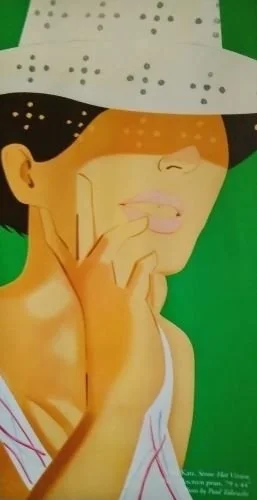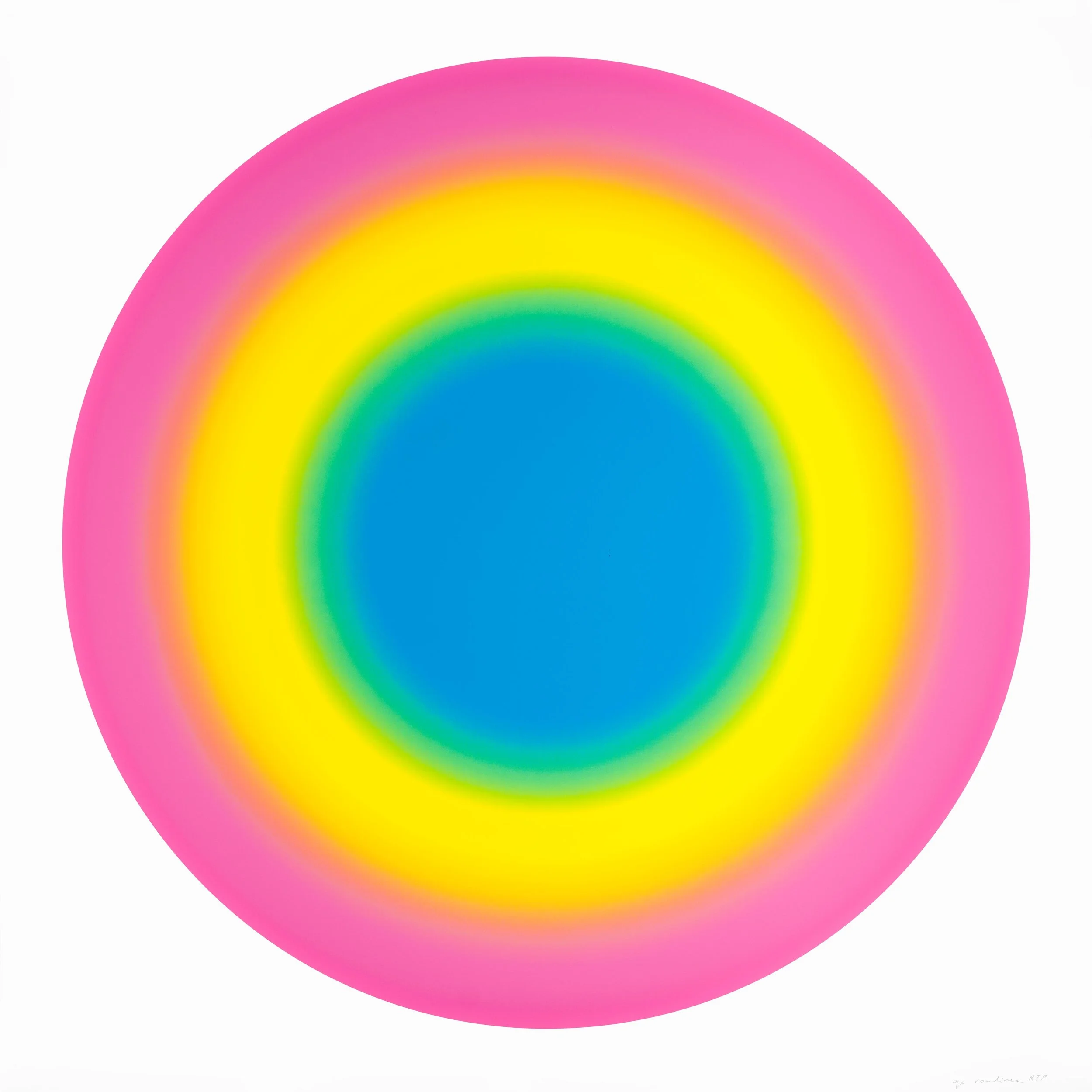Confessions Of A Fine Art Publisher
by Robert Lococo / Photography of artworks by Paul Takeuchi courtesy of Lococo Fine Art Publisher
Alex Katz, Straw Hat Vixen, 2021, silkscreen print, 79x44”, Photo by Paul Takeuchi
As auctions in the worlds of contemporary art and modern masters reach new heights of popularity and prices, it's starting to become hard for people - even those of means - to get into that market. However, I would argue that the most exciting part of the art world is one that has been around for centuries—prints—or more accurately described as the multiples market, as each image is typically printed in an edition of six to 100, giving more than one buyer a chance to own a piece of history.
For someone interested in owning an original Andy Warhol, prices run in the millions, with the most recent selling for $195 million in 2022. Even Warhol prints that sold for a few thousand dollars 20 years ago are fetching hundreds of thousands. For example, an edition print of Queen Elizabeth II fetched $855,600 at an auction this past November. But fear not, as there are still many opportunities to buy exceptional works that will appreciate over time as you appreciate them today on your wall.
Ugo Rondinone, Sun 6, 2019, silkscreen print on museum board. Photo by Paul Takeuchi
The print market has been growing forever. Pieter Brueghal was making multiples during the Dutch and Flemish Renaissance. Rembrandt didn't carve the copper used to make his prints. Instead, there were master printers that worked with him under his supervision. As time passed, the print process changed from woodcut to lithography to silkscreen and digital printing. Many artists can work in any of these mediums and prefer to switch around from time to time.
Kenny Scharf, Paradis Perdu, 2022, Archival pigment inks with high gloss varnish and diamond, 42x54”. Photo by Paul Takeuchi
Suppose you're a new collector. Where you start all depends on your financial ability. The fact is that most people buy art to decorate their homes. They want a picture that's 36 by 72 inches over the sofa. So when they're coming in, they're just thinking about what will look best. While this is a perfectly fine approach, considering that you can still buy a print in the $5,000 range from blue-chip artists like Andy Warhol, Alex Katz, Jim Dine, Robert Rauschenberg, or Jasper Johns, my decision would be based on more than just what matches the sofa.
Donald Sultan, 2020, Poppies series, Large prints on 4-ply museum board.
David Salle, Over Under (Red), 2021, Archival pigment ink with hand-varnish. Photo by Paul Takeuchi
For example, when we publish a print with Ugo Rondinone or Alex Katz, those prints go up in value as they sell out. And many of those prints are auctioned at Sotheby's and Christie's. So, that print in your living room has the potential to sell for more than you paid for it. In the meantime, even if you made your money back, you got to live with something beautiful for five years. Meanwhile, that sofa you were hoping to match likely didn't appreciate over the same period.
As a fine art publisher, I represent a group of 30 or so artists, and that artwork works together. Because of my design background, I have an innate sense of what will sell, and then I'll put the money into it. We finance our projects up front, and the artist is paid in full rather than as it sells, which is unique in the industry. If I believe in a project, I will go for it.
Some prints can take a year or longer from the artist's preliminary work to screen printing, proofing, and the final product. We don't do huge editions. It could be as small as six for a sculpture or as big as 100 to 150 for a print. If it's a real piece of 'candy,' meaning it's easy for people to digest, we'll print up to 150.
We recently did a portfolio by Alex Katz called Ada. It has ten prints in the portfolio. Eight of the prints are terrific. Two of the prints are tough, meaning that in my opinion, they might not be suitable for everyone. However, people who really know and follow Katz's work are the ones that will like them.
We like to publish a group of prints because often, like with the Ada prints, it's a canned exhibition for dealers worldwide. We're doing shows with this group of prints right now at galleries in Fort Lauderdale, Cologne, and Frankfurt, and because this is a brand-new release, we're just getting started. They'll be fighting for those prints before all those shows are over. In between these major projects, we'll maybe do a pair of prints, some woodcuts, linocuts, and a few digital prints, and then we'll go back to a silkscreen.
Sometimes an artist will give you a print that is a tough sell, but I never say no. That's the nature of the business. You take it, do it, and make the artist happy, then you're on to the next thing. If you're demanding and are slow at paying, artists can be hard to get on the phone. But, if you pay them fast to make a friend, have a good personal relationship, and don't complain, then you're okay.
Sometimes the prints are numbered, and sometimes it says AP for artist proof. An artist's proof is exactly like the edition. In my opinion, having an artist proof from the main edition isn't a greater value because when these prints are made, you can't tell the first from the last.
Etchings can be a different story because they ink a plate each pass in an etching. So what happens with the etching at the beginning is that the plates are often darker. Then, as you go through the edition, the prints get lighter. A real pro etching collector who collects Picasso etchings from an edition of 50 usually wants to buy 24, 25, or 26 in that edition because they feel like that's its heart.
There are also monoprints, meaning an edition of one. For example, we did a woodcut project called Grace with Alex Katz of 50 prints. Katz added more cuts as the edition was printed, so each edition of 50 was slightly different. While these are not considered monoprints, if Katz were to take just one of these and add a colored background, then it would become a monoprint, and its uniqueness would make it more valuable.
When we had them, the Reigning Queen prints from Andy Warhol sold for $5,000 a piece and were tough to sell. The last one most recently sold for $450,000. Why? When it comes to buying prints from younger or older artists, it depends on how the artist has set up their estate. In the case of Andy Warhol, when he died, his career wasn't at the top but fluttering in the middle. So, for the first year after his death, his estate didn't sell anything, opting to figure out what they had in inventory, and then decide to whom they would sell. There were 4,000 prints in the estate, and they released them gradually. The Warhol Foundation spent 25 years selling prints, raising prices until they sold out, and never selling any themselves at auction.
Most museums aren't focused on editions; they want originals. One exception is the Albertina Museum in Vienna, primarily a print museum. Next month the entire museum will be given over to Alex Katz prints with the publication of a new catalog raisonné. Based on the requests we're getting, European dealers are capitalizing on this spotlight by showing Katz's work over the next 90 days. So, for Katz, who was often underrated, the value of his work continued to rise.
Some of the new hot artists are doing prints and objects, but it's not the easiest thing to get a publisher. They may self-publish, but the headache of logistics and red tape often leads them to give up some money to have somebody with a good reputation take care of it. Unfortunately, many dealers and publishers like to short-change artists, which is a bad idea because you're not going to be rich on two extra prints. So when we're splitting prints with artists, the artist always gets the extra if it's an odd number.
Only a few artists make sculptures in editions. Some, like Donald Sultan, have a terrific print and multiples market. Many people aren't familiar with his work but fall in love with it when they see it. It works in both traditional and contemporary interiors. You look at it and smile, and you don't have to think any further.
David Salle is one of the 80's boys becoming very popular again, along with Kenny Scharf, Keith Haring’s roommate. While everyone doesn't like contemporary art, that market is becoming more significant daily. Check out one of the big art shows in Venice, New York, Miami, or even Chicago for proof. If you don't get tickets early, you may not get in.
While our business primarily sells to dealers, please call us if you have any questions. Check out our website (lococofineart.com), and if you are interested in one of our new editions, put your name on the waiting list before it sells out. But most of all, enjoy the process of collecting.





